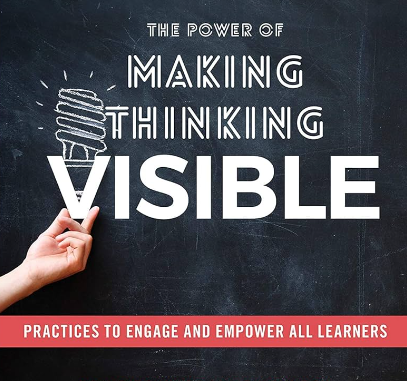
Summary
Hi everyone! This week I was able to implement an MTV strategy into my classroom that allowed for high student engagement and ownership of my first graders learning. Please continue reading to find out more!
The Main Points behind “Making Thinking Visible”
- Fostering Deep Learning
- Cultivate Engaged Students
- Change the Role of Students and Teachers
- Enhance our Formative Assessment Practice
- Improve Learning
- Develop Thinking Dispositions
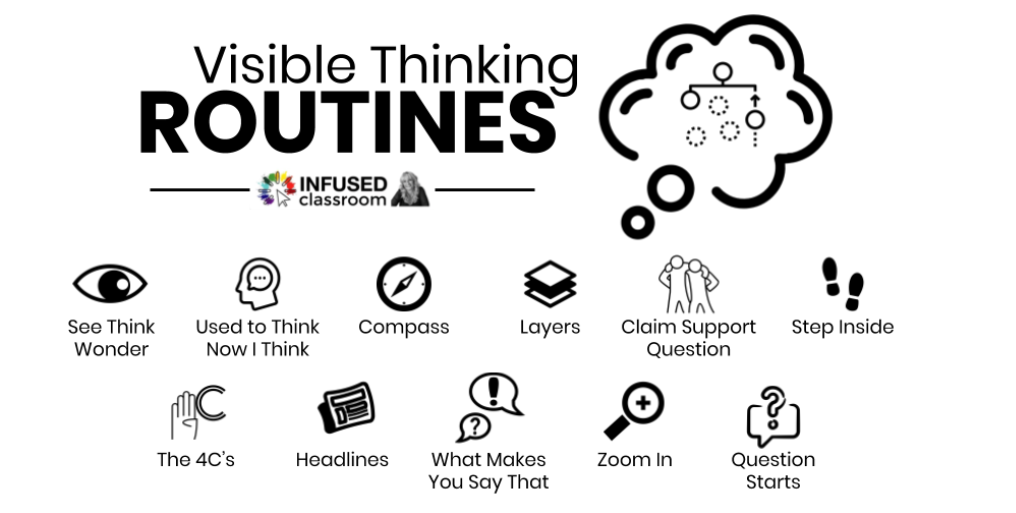
MTV’s Influence on my Teaching Practices:
As a teacher it is my job to provide students with these active learning experiences and incorporate MTV practices. By doing so, students can demonstrate critical thinking skills, grappling with complex task, build curiosity, and take ownership for their own learning. As a teacher I can increase my students engagement in lessons and activities as they make their thinking visible and converse with their peers about the relevant content. As thinking routines are implemented into my classroom, my students will become more aware of themselves and myself as the teacher am able to become more aware of my students understanding and questions they may have. I can use my students thinking as a formative assessment, as they verbalize their thoughts and ideas out loud. My students are able to feel that I value their thoughts and ideas. Therefore, it is important to demonstrate a strong appreciation for all students as they share their thoughts and ideas so that they can too begin to value their own thoughts and learning experiences.
Classroom Implementation: Peeling the Fruit
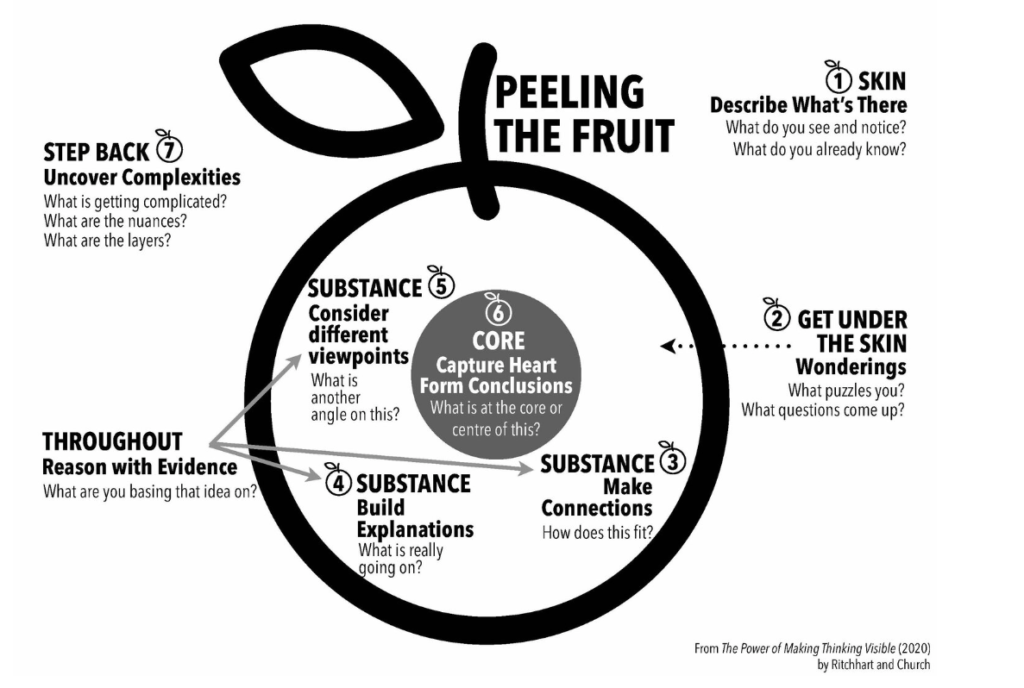
I was able to implement the thinking routine “Peeling the Fruit” with my first graders and it went really well! We started a new book this week in our reading program, Wit & Wisdom. It is the final book of Module 1. Green Eggs and Ham by Dr. Seuss. Module 1 is all about Books, as the title is “A World of Books.” This module is focused on demonstrating the power of reading and how it can change ones life. This book Green Eggs and Ham was different than the other books students have read previously in Module 1, as it was NOT about books or librarians. I was concerned that they would have difficulties making connections, as to why this book was included in this module, but I sure was WRONG. Lesson learned, NEVER underestimate the minds of first graders!
Lesson Successes:
Students were successfully able to:
- Notice a variety of things about Green Eggs and Ham using the words and illustrations throughout the story.
- Wonder as they asked different questions about the story using questioning words such as Who, What, When, Where, Why, and How?
- Establish connections to their own lives, as well as other books we have read in the Module.
- Define the Central Meaning/Message of the story, Green Eggs and Ham.
- Share their thinking with their classmates.
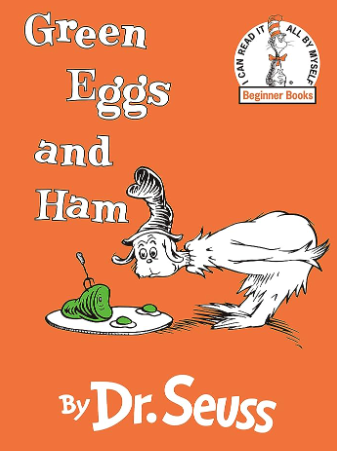
I was hesitant that my students were going to be able to make the connection to the text, but they did it! Students were able to use the Story Map anchor chart to help them do so. As a class we were able to first define the problem (beginning), then the action step (middle), and the resolution (end), in order to make the necessary connection. Students used their prior knowledge of the text as it was day 4 of reading the text to establish that The man did not want to try green eggs and ham and said that he did not like them, but then he finally decides that he would try them to make Sam leave him alone, but in the end after trying them he did in fact like the green eggs and ham.
I was able to ask students, How may this story connect to reading a book? I received a few different answers in which some students said:
- “You cannot say you do not like something if you have never tried it”
- “Be okay with trying new things”
- “You never know if you like it, unless you try it”
I was able to introduce students to a new quote, one that they were unfamiliar with:

I told my students that it’s so important to try new things, maybe it’s food, sports, or a book- even if you’re not sure that you will like it. Trying new things allows us to learn more about ourselves and if you say you do not like something and you have never tried it, you may be missing out on something good!
Lesson Challenges:
A challenge that I always face is time. In first grade we focus primarily on the foundational skills of reading. This is a struggle as we are only left with 30-45 minutes each day for comprehension practices. Therefore, with this week being a short week with end of quarter and fall break I was extremely limited on time. Next time, I will be sure to allow for 5 consecutive days to dive deeper into this literary connection and will even implement a writing activity that students write about a time that they tried something new and what their results were. Were they like the man in our story, Green Eggs and Ham? Did they try something new and love it? Or did they not like it? I cannot wait to learn more about my students as they make text to self connections with the story as they think of experiences their own lives!
TCE Threshold Concepts:
The curriculum is co-constructed–
MTV thinking routines allow teachers and students to be in control of the learning that is happening in the classroom. The teacher is not expected to lecture students all day as they “sit and get.” Students are expected to have joint input on the lessons as the students learn from each other, the teacher learns from students, and the students can learn from the teacher. The teacher role is not just one of the adult in the room, but all students are able to teach one another and learn from one another. This concept allows for the teacher to sit back and observe students from a different viewpoint in order to gain insight on their understandings. It is important that the teacher orchestrates the lessons, but then students drive the instruction/learning in order to maximize student and teacher involvement.
Teaching and learning honor people’s full humanity–
Each students perspectives, thoughts, experiences and ideas are valued in the classroom. The classroom is a place where all students feel welcomed and comfortable to take risk and try new things. Students feel like their voice is heard by the teacher as well as their peers in order to grow as individuals. The environment is inclusive to all students who enter the classroom and everyone is given equal opportunities to learn. The golden rule, of “treat others the way you want to be treated” aligns to these MTV strategies as students are stepping out of their comfort zones and taking ownership of their learning they must be willing to listen to others share their thoughts and ideas in order to gain new perspectives and insights.
Social Media Post: Twitter & Pintrest
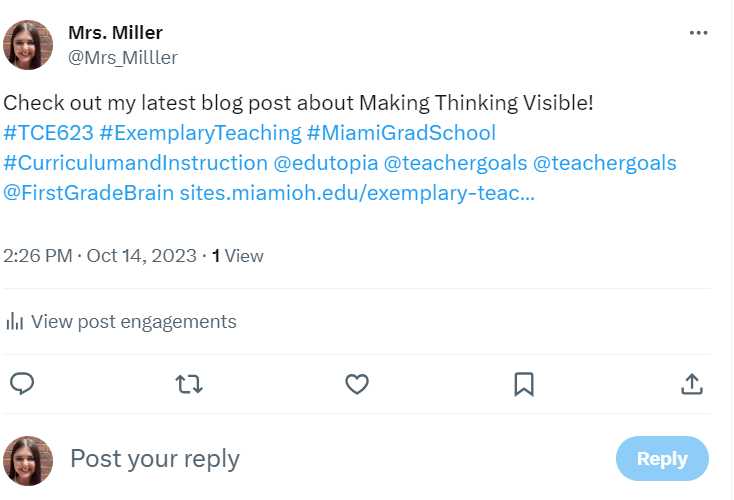
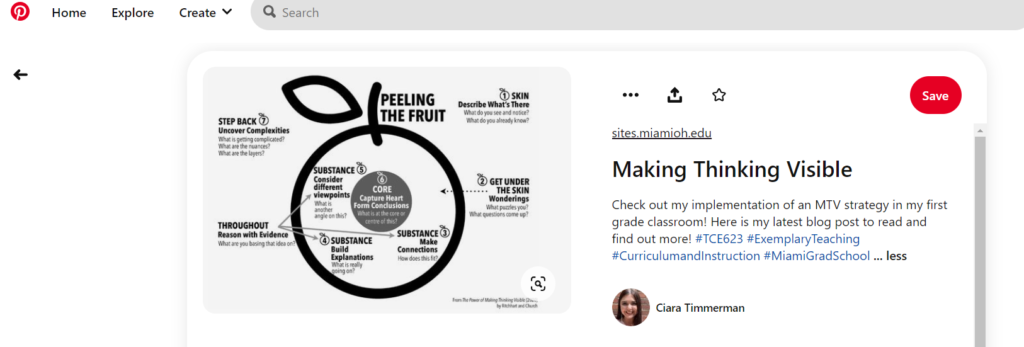

Hi Ciara!
You are so right, we can never underestimate the power of the minds of youth. They know very little but know a lot at the same time and even at young ages, because of their innocent view of the world, they can say things that cause us to think even in our adulthood. As I was reading your statements on the MTV strategy, “Peeling the Fruit, it seemed that you and your students had many great outcomes. They were asking the critical, thought-provoking questions that cause you to have to think deeply and not in a vague manner.
It’s great to hear that they were establishing connections to their own lives as well. A book such as “Green Eggs and Ham”, to us, may seem so childlike but even now I “read” picture books and still gain a lot from just looking at visuals. As they say a picture holds 1,000 words and I think that even for the little ones, the way they envision what they read, pictures and all, can hold a lot of meaning for them as well. Teaching critical thinking skills and how to unpack even simple texts gets them in the frame of mind that words hold power and always deserve a deep dive into so that we can explore broader meanings and messages. It’s great that you provide them with moments to converse and talk about their learning out loud. Elementary teachers definitely play a huge role in shaping the minds of youth and I think with your teaching practices, strategies, and mindset that you are preparing them for much greatness!
I came across this blog post on the historical perspective of the “Peeling the Fruit” and thought it would cool for you to check out! http://mrsslaviero.blogspot.com/2016/05/historical-perspective-and-peel-fruit.html
Thanks for sharing your thoughts!
Hi Jade,
Thank you for reading my post! I just read that blog post about Peeling the Fruit, thank you for sharing. I feel like this strategy has many benefits for students to get to the “core” and can be used in various subject areas. I was able to implement it into a literacy lesson, however I am interested in using it in math, science, and social studies in order for my students to build connections and ask and answer questions to gain a deeper understanding of our first grade content. You are so right, that my students say things that make me think all the time, even sometimes students ask me questions that I have never thought of myself! It is so enlightening to know that they are curious about the world around us!
Hey!
I understand about the time issues! I find that we always need more time because our Phonics takes such a big part of our ELA block. We often have to stretch out our lessons into 2 days depending on the content. I was interested to see how the Peeling the Fruit routine would go because I think it can be easily implemented into our Wit & Wisdom curriculum. I always find it amazing how our students can come up with connections whether its with their own personal lives or outside books!
For your TCE connections, I agree that there are so many ways to learn from each other in the classroom. Personally, I find that our students learn best through peer interactions, but at the same time, I find it challenging to make sure that I scaffold discussions rather than lead them too much. They always surprise me with their feedback for each other. I did read on a few of our other classmates posts about the Ladder Feedback and I definitely found that it would help some students give feedback to one another and there is a great visual that goes along with it.
Thanks for sharing!
Hi Brittany,
Thanks for the reply! I agree that Peeling the fruit was an easy connection to build into Wit & Wisdom. It is definitely hard to just listen to my student’s conversations sometimes without intervening too much! However, you are so right, they can learn so much from each other with cooperative learning practices. I am glad to hear that you too were able to make connections for your students as well!